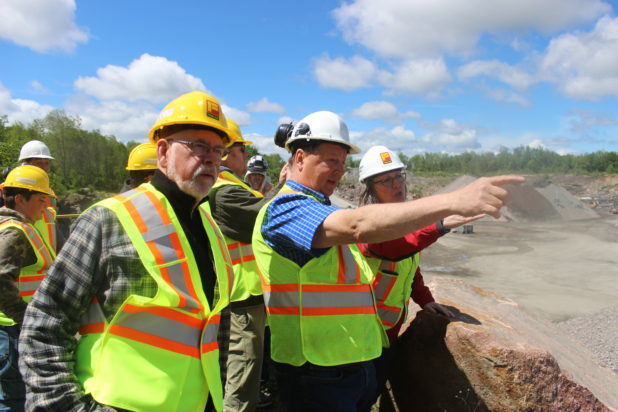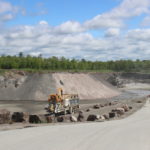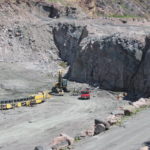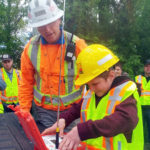Headline News
A glimpse into the future of a quarry in Bancroft
June 8, 2017

From left, Gaebel Road resident Larry Edgar discusses what the Freymond quarry would look like in comparison to the Fleming Quarry with Freymond Lumber Ltd.’s Dan Freymond and Fowler Construction president Moreen Miller. / SARAH SOBANSKI Staff
By Sarah Sobanski
Early morning June 1 saw more than 20 community members pack up and bus out to Orillia to tour Fowler Construction’s Fleming Quarry.
The 33 hectare quarry is comparable to the proposed Freymond quarry in many ways. In size, the Fleming Quarry represents two times the size of one fully operational phase of what the proposed 70 hectare, four phase local quarry will look like. It has the same production of 300,000 tonnes of aggregate per year. It’s in a tourism-based economy, is surrounded by cottages and a lake and is bordered by wetlands.
The wetland is within 10 metres of the quarry and well below it. It’s also 23 metres below water levels of nearby Lake Couchiching. While the quarry was dotted with wet spots along some of its faces, Fowler materials manager and tour guide James Gordon gives the impression the quarry only needs to pump water out from snow melt and rain.
Down wind, along the outer edge of the quarry, it sounded like any construction site. The secondary and tertiary granite crushers created a constant, grinding hum punctuated by the trucks and loaders working below. The primary crusher had been pulled away from the site for a later blast.
Gordon said the primary crusher wouldn’t be louder but would have a less consistent noise.
Freymond Lumber’s Dan Freymond noted that people often assume having two pieces of equipment that make noise means double the noise. He said it doesn’t, it increases minimally as they both create the same amount of noise.
If the quarry was anything, it was dusty. A constant cloud puffed from where aggregate was being piled. President of Fowler, Moreen Miller, explained this wasn’t average. It was an extra windy day, turning up dust and sand like a car on a gravel road.
On the tour’s way out, the bus stopped on the other side of the wetland. One man commented the birds were louder than the low rumble of the quarry. The swan, atop a pond of the wetland just outside its border, certainly didn’t seem to mind.
Later, when the tour stopped 500 metres from the quarry, and then 800 metres away, it couldn’t be heard at all. What could be heard, was the blast.
Miller explained very similar blasting techniques would be used at the Freymond quarry. She also noted that smaller, more frequent blasts or larger, less frequent blasts were something that could be negotiated with the community.
Fowler set up a 40,000 tonne blast. Miller said the quarry had an agreement with the community to blast between 1 p.m. and 3 p.m. There was also a calling list used to notify those who wanted to know in advance that a blast was scheduled.
For safety reasons, the street was shut down from the quarry to where the tour gathered, just outside of a subdivision and within view of the lake. A five-minute warning horn sounded quietly in the distance. Another horn sounded at a minute.
Finally, a sound resembling a gun shot. Other tour attendees compared it to fireworks, quieter than a lightning crack but just as quick.
Over the course of the day one large truck was noticed transporting aggregate. A woman asked about the truck traffic after seeing it.
Land use planner with MHBC Planning Urban Design and Landscape Architecture Brian Zeman said each truck carries up to 25 tonnes of product.
“If there’s projects requiring aggregate those trucks will be in the community,” said Zeman. “It’s not a situation of trucks or no trucks.”
Miller noted there would be more trucks in the summer, less in the winter.
Zeman expected the County of Hastings and Faraday township to complete their reviews of the Freymond quarry application and submit comments within the next few weeks.
- The Fleming Quarry is around 33 hectares. It’s roughly double the size of one operational phase of the Freymond quarry. / SARAH SOBANSKI Staff
- Crews set up a 40,000 tonne blast at the quarry. / SARAH SOBANSKI Staff
- Jeriah Bauman stands with Fowler’s John Newton waiting for the warning horns to set off a blast at the Fleming Quarry June 1. The blast was compared to a gun shot or fireworks. / SARAH SOBANSKI Staff





















You must be logged in to post a comment.